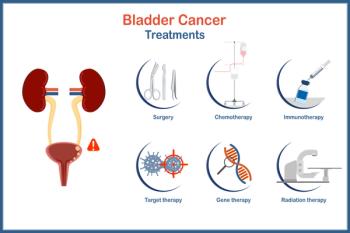
New Study May Help Improve Prediction of Bladder Cancer Recurrence
Key Takeaways
- Researchers developed a predictive model for NMIBC recurrence using radiomic features and clinical variables, showing promise in precision oncology.
- Ten machine learning models were tested, with the support vector machine model achieving the best performance in predicting recurrence risk.
Researchers in China combined findings from MRI scans with clinical features to create a new predictive model for nonmuscle-invasive bladder cancer recurrence.
Researchers from the Second Affiliated Hospital of Kunming Medical University in China recently conducted a study that may help doctors better predict whether nonmuscle-invasive bladder cancer (NMIBC) will recur within two years after surgery.
NMIBC is a common form of bladder cancer where the tumor has not invaded the muscle layer. Approximately 80,000 people in the U.S. are diagnosed with bladder cancer each year approximately three-quarters are diagnosed with NMIBC. Although it is typically treated through
First author Bo Chen and other researchers, most of whom are affiliated with Kunming Medical University in Kunming in the Yunnan Province of southwestern China, conducted the study. The
Chen and the other researchers analyzed data from 183 patients with NMIBC between January 2017 and January 2023, 57 of whom experienced recurrence within two years and 126 did not. Using multiparametric MRI scans, the investigators extracted
By using these feature selection methods, the researchers identified four key radiomic features and then combined them with six clinical variables taken from the European Association of Urology risk stratification. Together these factors formed the basis of predictive models designed to estimate recurrence risk.
“Our model was carefully checked and validated with external data and had relatively good results,” the authors wrote.
Ten different machine learning models were built and compared, including logistic regression, decision trees, gradient boosting,
“The goal was to determine which approach best identified patients likely to experience recurrence within two years,” the authors wrote. “To test robustness, the models were validated internally across different wards in the same hospital and externally using independent datasets from two other hospitals that included 108 additional patients.”
Among the tested models, the support vector machine approach performed best. In training, the SVM model achieved an area under the curve of 0.973, while in internal validation it reached 0.891. Applied to external cohorts, the model achieved AUCs of 0.88 and 0.87, indicating good generalizability across different patient populations.
The researchers also developed a nomogram that combines the radiomics score and clinical variables, providing an intuitive way for doctors to estimate recurrence probabilities for individual patients. Calibration plots suggested the model’s predictions closely matched observed outcomes and decision curve analysis indicated that its use could offer clinical benefit by improving patient risk stratification.
Chen and colleagues acknowledged some of the limitations of their research, including the retrospective design, which raises the potential for selection bias, and the reliance on manual tumor delineation, which introduces human subjectivity. They also noted that patients treated with immunotherapy or those with carcinoma in situ were not included in this analysis.
The study also did not incorporate molecular biomarkers or genomic information, which could further improve predictive power.
However, by moving beyond the limitations of traditional risk scores, they said they believe the approach represents a step forward in precision oncology and could help improve outcomes for bladder cancer patients worldwide.
Newsletter
Get the latest industry news, event updates, and more from Managed healthcare Executive.






















































